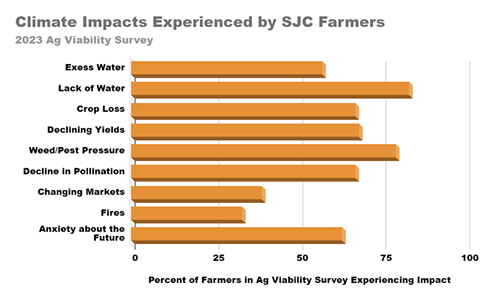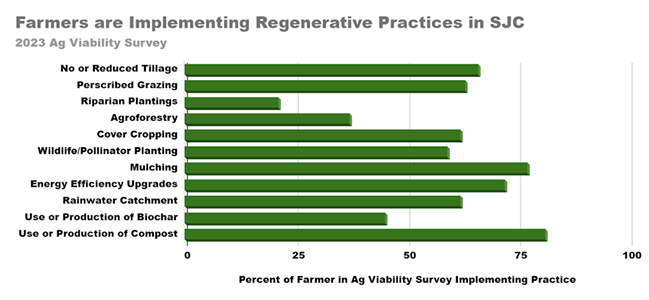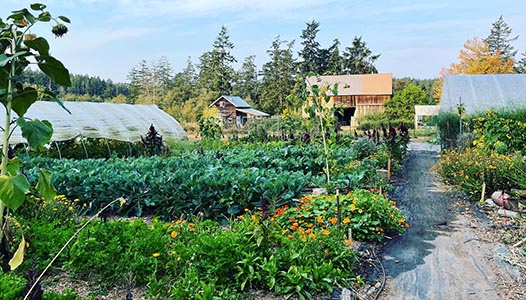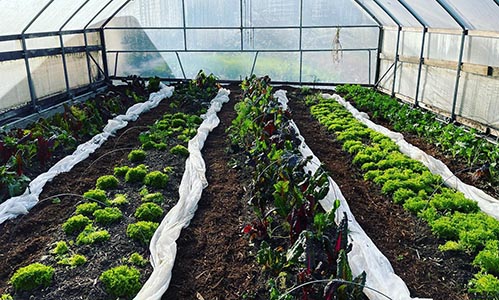||| FROM ISARA GREACEN, CLIMATE COMMUNICATIONS INTERN |||
We’re a very long way from producing all of our own food. Right now, only around 3.5 to 4% of the food that’s purchased in San Juan County is grown here,” explains Faith Van De Putte from Midnight’s Farm who also serves as the county’s Agricultural Resource Committee Coordinator. In the San Juan Islands, food resiliency is a vital part of community member’s livelihoods and it is more important than ever in the face of climate change.

The changing climate creates new obstacles for agriculture in the islands. Farmers are facing wetter springs that delay planting and disrupt pollination, followed by hotter, drier summers that bring drought and the risk of total crop failures. Van De Putte recalls the devastating heat dome from three years ago which led to multiple farms losing their entire crops: “Those kinds of events can have a very big impact. Anytime we go outside our normal bounds, there’s going to be effects.”
Nathan Hodges of Barn Owl Bakery concurs: “It’s really difficult to predict overall changes in weather patterns due to climate change.” Nathan Hodges and Sage Dilts grow some of their own grain for the bakery and share that to mitigate this unpredictability, they focus on building diversity within their grain seed bank. “Rather than relying on one very productive monocrop that is genetically identical across all the individuals…we rely on thousands of genetically distinct individual plants and seeds, so that in any given year, there’s always going to be some plant that will do well,” Hodges explains.

In the face of these unpredictable and increasingly severe conditions, the need for a resilient foodsystem has never been more critical. Van De Putte shares, “When I think about resiliency, I think about redundancy in systems.” Applying this to the food system in the islands, she identifies “having home gardens that are producing food, having a vibrant local agricultural community that’s producing food at a variety of scales, having the infrastructure that’s needed to process and store the food that’s grown here and distribute it, and then having the connections to the mainland and the ability to import food in different ways, through different channels.”
As the San Juan Islands become a more attractive refuge from climate extremes, the local food system will face increasing pressure. “We’ll see more people move here and have more of the climate refugee situation,” Sage Dilts from Barn Owl Bakery predicts. This rising population could strain an already fragile food system, which, as Dilts points out, “is not really prepared for
large-scale demand.”

The high cost of land and labor further complicates the situation for farmers in the islands. Van De Putte explains, “Land access for new and beginning farmers is a huge challenge and is going to continue to be. When the value of the land is completely divorced from the productive value of the land, you can’t pay off land by farming it.”
To strengthen the resiliency of San Juan County’s food system, a multifaceted approach is needed—one that combines financial support, community education, and policy changes to support sustainable agriculture. Supporting existing programs that are crucial to the community’s food system is also essential. Hodges underscores the collaborative spirit that defines the
county’s approach to food resiliency. “There are a lot of individuals, institutions, nonprofits, and government entities that have a lot of passion and interest and desire to build a very functional food system in the islands,” he says.
One of these organizations, Lopez Community Land Trust (LCLT) has played a crucial role insupporting the county’s agricultural sector for over 30 years. LCLT provides access to farmland through three agricultural leases: Stonecrest Farm & Graziers, Still Light Farm, and Barn Owl Bakery & Heritage Grains. LCLT has also been instrumental in educational efforts, helping found the Lopez Island Farm Education (LIFE) program at Lopez School which helps students learn in a hands-on way about local food system.
As San Juan County faces the dual challenges of climate change and a growing population, the need for a resilient and sustainable food system has never been more urgent. By investing in local farmers through grants, educating the community about the benefits of local food, and continuing to support vital programs, the islands can build a stronger, more adaptable food
system. As Rhea Miller, LCLT Community Liaison, reminds us, “It’s up to us to help educate and support each other to ensure that our local food system thrives.” However the road ahead requires more than just practical solutions. We must come together, whether on the farm, as an island, or as a county, to face the challenges of our time. As Van De Putte says, “It’s a lot easier
to be courageous with a community than to be alone in the face of climate change.”
Isara Greacen is a Climate Communications Intern for the Lopez Community Land Trust. She grew up on Lopez Island and now attends Scripps College. To read the full-length version of this article, visit www.lopezclt.org/fire-risk-and-climate-change/.
**If you are reading theOrcasonian for free, thank your fellow islanders. If you would like to support theOrcasonian CLICK HERE to set your modestly-priced, voluntary subscription. Otherwise, no worries; we’re happy to share with you.**










Islanders should be proud of the work being done by these neighbors. Their foresight and operational approach to the climate challenges we will face in the future deserve respect, funding, and first level support from San Juan County and our legislators.
““Land access for new and beginning farmers is a huge challenge and is going to continue to be. When the value of the land is completely divorced from the productive value of the land, you can’t pay off land by farming it.” If SJC is ever going to do better than < 5% locally grown food, there must be MANY more farmers, gardeners and foragers entering the field (pun intended!).
Perhaps one part of a solution to making farmland available to young farmers is to revise the Farm and Agricultural Land tax code?
https://www.sanjuancountywa.gov/793/Farm-and-Agricultural-Land
At the moment the VAST majority of leased farmland is simply mowed annually, ostensibly for hay but really for the agricultural "use" tax break. We all supposedly benefit from the open space, but I question which is actually more important to the citizenry of the islands, farmer-free leased hayfields that the wealthy owners pay no taxes on OR a healthy variety of small farms, ranches and orchards? By enforcing ACTUAL agricultural use of those tax parcels that preserve and improve the health of the soil and environment, perhaps we can get our money's worth from the tax breaks we have given a few owners of large parcels? An organized system for long-term farmland leasing might be part of the solution to raising more of our food locally. Perhaps the Ag committee could formulate and administer a standardized land lease system that would protect landowners, lease-holders AND the environment?